
Antropolozi i arheolozi saglasni su da su šare (“crteži”) koje su crtali preistorijski ljudi po zemlji ili na zidovima pećina imale magijska svojstva, tj. da su bile deo rituala (za uspešan lov, bogatu setvu, plodnu zajednicu). Ali niko sa sigurnošću ne može da kaže da li je to beleženje vertikalne komunikacije nastalo iz ili kao deo horizontalne, ili kao posledica usložnjavanja percepcije. Drugim rečima, da li je dodavanje magijskih svojstava u komunikaciju stvorilo potrebu kod naših predaka da je zabeleže, vizuelno iskažu? “Molim ti se Bože...” iskazano kroz crteže lova ili figurine boginja plodnosti predstavljaju već viši nivo komunikacije, kada se uvode elementi imaginacije, poput metafore, personifikacije, simbola, i kada dolazi do polipercepcije – drvo jeste i deo šume, i objekat koji stvara hladovinu ili štiti od kiše, i materijal od koga se pravi oružje ili vatra, ali i stanište duha/ božanstva (ili on sam) koji je ljudima podario vatru i oružje, koji ih štiti od sunca ili kiše. Usložnjavanje percepcije uslovilo je i razvoj društvenih odnosa, što znači i komunikacije, čime se javila potreba za trajnijim prenošenjem poruke ili memorisanjem, jednako i u vertikalnoj i u horizontalnoj ravni komunikacije. Verbalni iskaz, zbog svoje trenutnosti, pokazao se kao nedovoljan, te su pronalaženi trajni, beleženi vizuelni načini saopštavanja, čime su stvorene osnove za razvoj procesa koji su doveli do savremene komunikacije. Služenje magijskom zamenjeno je magijom kombinovanja vizelnih značenja.
Slobodanka Stupar već više od dve decenije istražuje upravo tu magiju značenja vizuelnog i njene kombinatorike. Posle višegodišnjeg bavljenja grafemima, kao vizuelnim nosiocima ideja, od početka devedesetih upušta se u istraživanja savremenih komunikacija zasnovanih na dekonstruktivističkom odnosu označenog i označitelja, i to u onom delu koji je Derida
Anthropologists and archaeologists agree that ornaments (“drawings”) drawn by prehistoric people on the ground or on the cave walls had magical powers, i.e. that they were part of various rituals (related to a successful hunt, a good harvest, a fertile community). But, no one can claim with certainty whether such registering of a vertical communication started from a horizontal one or it was part of it. Or, it was a consequence of perception which became more complex in time. In other words, did this adding of magical elements generate in our ancestors a need to record and express that communication visually? “I pray to thee, God…” expressed in the form of hunting scenes or a figurine of the Goddess of Fertility represented a higher lever of communication after the elements of imagination, such as metaphor, personification, symbols, had been introduced, and after polyperception had appeared – a tree is part of a forest, an object that casts shade or protects from rain, a material one can use for making a weapon or lighting up fire, a dwelling place of a spirit/god, and a deity that has shown the humans how to use fire and weapons and that protects them from the sun and rain. This more complex perception influenced development of social relations, i.e. communication. It resulted in a need for a permanent transmission of messages or for remembering both on the vertical and horizontal levels of communication. Verbal expression turned out to be insufficient because of its instantaneousness. Therefore, some permanent and recordable visual ways of communication were being found and that led to the establishment of some basic grounds for development of processes which resulted in contemporary way of communication. Serving to something magical was substituted by the magic of combining visual meanings.
 Forcing the Subjectile, 1997. Postavka u Artforum galeriji Solun 2001. Forcing the Subjectile, 1997. Artforu Gallery Thessaloniki exibition view, 2001.
Forcing the Subjectile, 1997. Postavka u Artforum galeriji Solun 2001. Forcing the Subjectile, 1997. Artforu Gallery Thessaloniki exibition view, 2001.
(Jacques Derrida) opisao kao predrasudu da se “slobodna igra jezika” svede na jedno stabilno značenje izjednačeno s karakterom govora. I ako bi se tražilo teoretsko uporište za ta i potonja istraživanja Slobodanke Stupar, u kome je znak i dalje nosilac izraza, onda bi se ono moglo naći u terminu difference, koji podrazumeva ideju da igra označavanja uvek odlaže stvaranje značenja. U novom ciklusu radova ona fokus pomera sa načina na koji je rečeno (označitelja) na ono što je rečeno (označenog) i to na imanentnost konstrukcionih delova reprezentacije, jasno ukazujujući da joj je teorijski oslonac, takodje Deridin termin, subjectile. Odgovarajući na pitanje koje sam postav-


lja: “Šta je subjectile”, Derida
kaže: “Koncept pripada kodu slikarstva i odnosi se na ono što na izvestan način leži ispod (sub-jectum) kao materija, subjekat ili duh. Smešteno izmedju onog što je gore i onog što je ispod, istovremeno je i nosilac i površina, ponekad je, takodje, i materijal slike ili skulpture, sve izmedju, što može da se izdvoji od oblika isto kao i od značenja i od reprezentacije” (Derrida, Forcener le subjectile, Pariz, 1986). Pronašavši u Deridinom “kodu” onu arhetipsku magiju stvaranja, u sub-jectumu i prostor delovanja i formu reprezentacije, a u dekonstrukciji metod, Slobodanka Stupar stvara novu seriju radova, nastavljajući prethodna istraživanja vizuelno-značenjskog odnosa slova i reči u cilju stvaranja sopstvenog rečnika/jezika, ali ovoga puta s pozicije prihvatanja jedinstvenosti svih gradivnih elemenata. I baš kao što je Derida preuzeo termin subjectile od Artoa (Antonin Artaud) i dekonstruisao ga
Slobodanka Stupar has been researching that very magic of visual meanings and its combination possibilities for more than two decades now. After she had been focusing on graphemes as visual carriers of ideas, this artist started to explore some contemporary ways of communication based on that deconstructive relationship between a signified and a signifier, at the beginning of the 1990s. Slobodanka concentrated on the segment Jacques Derrida had described as a prejudice against the reduction of “free language play” to one steady meaning which would be equal to the character of speech. If we looked for a theoretical base of those and latter researches conducted by Slobodanka Stupar, where a sign continued to be a carrier of expression, then we might find it in the word difference. This word understands the ideas that a play on signifying always postpones creation of meaning. In her latest cycle of works, Slobodanka shifts her focus from the way of speaking (signifier) to what has been spoken (signified), more precisely to immanence of construction parts of a representation, clearly showing that her theoretical support can be found in Derrida’s term subjectile as well. Derrida offers us the following explanation as an answer to his own question what a subjectile is: “The concept belongs to the code of painting and refers to that which, in a way, lies below (sub-jectume) as a substance, a subject or a succubus. Placed between the above and the below, it is both a support and a surface, sometimes it is also the material of a painting or a sculpture, everything within them which can be distinguished from form as well as from sense and
mova u drugi jezik (u svakom smislu), tako je i Slobodanka Stupar bavljenje kontekstualizacijom slova/reči u vizuelnoj reprezentativnosti prepustila njihovoj (vizuelnoj, zvučnoj, idejnoj) imanetnosti, preuzevši na sebe ulogu da beleži/snima pozicije, slučajne i nameštene, bez želje za objašnjavanjem njihovog značenja, za prevodjenjem.
Posveta ovom novom ciklusu jeste rad “Forcing the Subjectile” koji istoimeni Deridin tekst postavlja u sakralni odnos – na postolju, svojevrsnoj časnoj trpezi, nalazi se “knjiga (nad knjigama)”, prepisani tekst čije su stranice okovane železom, čime se simbolično ne dozvoljava nikakav upliv sa strane, dok se na zidu nalazi ikonoliki triptih s ispisanim istim tekstom. Sakralizacija jednog teksta nije izvedena samom postavkom, već sučeljavanjem dva kreativna vida (pisane reči i slike) u istom diskursu, čime su naglašeni njihovi apsoluti i ostvarena, na vizuelnom nivou, Deridina ideja o jedinstvenosti jezika i njegovoj neprevodivosti, čime i posetilac koji stupa u taj
“sveti prostor” biva uvučen u pitanje (da se poslužimo Deridinom metodologijom (kao što to čini i Slobodanka Stupar):
“Da li je samo Biblija na aramejskom
jedina prava (original), dok su latinska
Vulgata, grčka Septuaginta ili Biblija
kralja Džordža, kao prevodi, nove knjige
representation, that which escapes representation” (Derrida, Forcener le subjectile, Paris, 1986). Having perceived that archetype magic of creating in Derrida’s “code”, a domain of creating and a form of representation in sub-jectum, and a method in deconstruction, Slobodanka Stupar created her latest series of works, thus continuing her previous investigations of visual and semantic correlation between letters and words for the purpose of generating her own vocabulary, but this time from the position of accepting uniqueness of all constitutive elements. Just like Derrida who took the term subjectile from Antonin Artaud and deconstructed it in order to point out, in his own way, that terms cannot be translated into another language (in every sense), Slobodanka Stupar transferred her focusing on contextualisation of letters/words in a visual form of representation onto their (visual, sound and conceptual) immanence, taking upon herself the role of registering/recording both accidental or staged positions, without any desire to explain their meaning, to translate them.

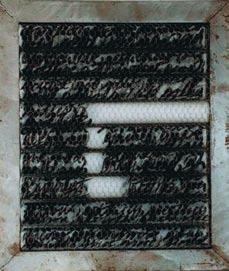
Forcing the Subjectile embodies the essential idea of this latest cycle created by Slobodanka Stupar. It transforms Derrida’s text bearing the same title into a sacral object – there is a pedestal, an honourable feast table, “the Book of Books” on it, a copied text with iron-bound pages, which prevent symbolically any influence enter from the outside; then there is a wall, an icon-like triptych with the same text written onto it. One can perceive the text as sacral thanks to the very set-up and the position of two creative forms (the written words and the image are opposite each other) in the same discourse, by means of which their absolutes are emphasized and, on the level of the vis-
 Misterija Pisma 1997. Myistery of Letter 1997.
Misterija Pisma 1997. Myistery of Letter 1997.
(originali) s novim značenjem i novom porukom”? Ali i ovaj pogled je samo subjektivno vidjenje kompozicije, čime je ispunjen koncept autoriteta mesta, upravo onako kako na to upućuje Derida kada koristi reč subjectile – kao ono što se “širi pod figurama (objektima) koje su bačene na to...” u čemu se ostvaruje neprestana promena u smislu kreativne reprezentativnosti odnosom subjekta i objekta, “komunikacijom dva apsolutna originala” (Derrida & Thevinin, 1998). Pošto se subjectil nalazi “i iznad i ispod” što objedinjuje i značenje i reprezentativnost, on je uzdah, papir, koža, tekstil, i slikarsko platno, a sve to kako bi se podržao i materijalizovao izgovoreni, napisani ili naslikani govor. Odgovar na Deridino pitanje “Kako možemo da udjemo, perforacijom ili defloracijom, u nešto što nije konzistentno osim onoga što je izmedju” Slobodanka Stupar pronalazi upravo u tom beleženju potencijalnih situacija – slučajnih, kao ishodište, i nameštenih, kao posledica. U tom smilu treba posmatrati i video radove “What is a Subjectile” i “Horizontal – Vertical”, kojima je istraživanje mogućnosti odnosa dva jezika (apsoluta) posmatrala s novog aspekta – i kao komparativne i kao suprostavljene i kao komplementarne strukture. Vizuelna komponenta prelaska četkice preko lica/šake upotpunjena je zvučnom, i to elementima njenog imaginarnog rečnika – u prvom, to su delovi Deridinog teksta, nasumično montirani, a u drugom, slova alfabeta iskazana kroz izdisaje – čime je direktno naglašena višeslojnojnost percepcije. Magija ispisivanja (podržavanja i materijalizacije) značenja (koje kreira receptor), iskazana je kroz relaciju nevidljivog definisanja već postojećeg

ual, Derrida’s idea of the uniqueness of language and its untranslatability is realised, and this confronts the visitor her/himself, entering that “sacred site”, with the following dilemma (let’s use, at this point, Derrida’s methodology the way Slobodanka Stupar does it): “Is the Bible written in the Aramaic language the only original, whereas Vulgata (a translation in Latin), Septuaginta (a translation in Greek), or perhaps King George’s Bible as its translations represent new books (originals) with new meanings and new messages?” However, this point of view is merely a subjective perception of the composition, thus fulfilling, to the full extent, the concept of authority of the site in the very way Derrida refers to it, when he uses the word subjectile – as something that stretches out under the figures that are thrown upon it......” and in which a constant change, in terms of a creative form of representation, takes place via the interaction between a subject and an object, “communication between two absolute originals”(Derrida & Thevinin, 1998). Since subjectile is placed “between both the above and the below”, which units together a meaning and a form of representation, it is a sigh, paper, skin, textile and a canvas, and all of that in order to support and materialise the spoken, written or painted speech. Slobodanka Stupar finds an answer to Derrida’s question:” How can we enter via perforation or defloration something that is not consistent, except the thing which is between?” in that very noting down potential situations – accidental ones as starting points, and staged ones as consequences. In this respect, one should view the artist’s videos What


entiteta, lica/šake kao jednog od nosilaca čovekove karakterizacije (identiteta, značenja), i (ne)razumljivih
zvučnih definicija glasova i reči. Zamena ljudskog oka
objektivom video kamere
još je jedan od metoda proboja u “izmedju”, koji ukazuje da je lepota (magija) jednog jezika (medija) upravo u njegovoj neprevodivosti.
Nedefinisanost (neprevodivost) tog “izmedju” (iznad i ispod), čime se otvaraju bezbrojne mogućnosti percepcije (komunikacije) i transpozicije u sopstvenom jeziku (mediju), za Slobodanku Stupar poseduje onaj magijski element, neophodan za kreativni čin, bez obzira da li se radi o ateljeu ili imaginativnom delu mozga. “Chronicle”
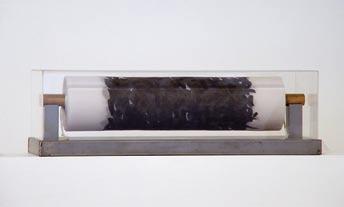

i “More pojmova”
pokzuju upravo dve (moguće) situacije te magije stvaranja, a istovremeno, i dva (moguća) logička niza istraživanja subjectil-a. Imajući u vidu i Deridino tumačenje subjectil-a kao prostora u kome se nalaze
“totaliteti predmeta, konfiguracija i učešća”, što mnogi tumače kao mesto, i Burdijevo (Pierre Bourdieu) mišljenje o odnosu umetnikovog habitusa i radnog prostora, ona kroz
is a Subjectile? and Horizontal – Vertical. In these videos, Slobodanka observed researches of possible interactions between two languages (absolutes) from a new angel – as comparative, confronted and corresponding structures. The visual component of brush movements over the face/hand is supplemented by the sound component by means of the elements of her own imaginary language – in the first video, those are passages from Derrida’s text placed randomly; in the second one letters of an alphabet are sighed out – with which multiple levels of perception are emphasized directly. The magic of creating (support and materialisation) of meanings (created by a receptor) is expressed via a relation of invisible defining of an already existing entity, the face/hand as one of the carriers of one’s characterisation (identity, meanings), and via (un)intelligible sound definitions of voices and words. Replacing the human eye with a camera lens is one more method of penetrating into the “between” which shows that beauty (magic) of a language (medium) is in its untranslatability. Indefinibility (untranslatability) of that “between” (the above and the below), which opens numerous possibilities of perception (communication) and transpositions into one’s own language (medium), possesses for Slobodanka Stupar that element of magic, an element necessary for the act of creativity, regardless of the fact whether it is an atelier or an imaginative part of the brain.

 Artforum galerija, Solun 2001 i 2006.
Artforum galerija, Solun 2001 i 2006.
ova dva rada akcentira
taj intuitivni, neracionalni momenat, kao neku
vrstu kreativne igre u čijoj pozadini leži ona iskonska magija stvaranja. U prvoj situaciji fokusiran je proces stvaranja, kada i nuzproizvod može da postigne nivo samostalnog rada, dok je u drugoj to bezbrojnost mogućih završetaka. Polazište je isto – lični imaginarni rečnik , sastavljen od reči i pojmova tri jezika, kao markirne tačke prostora – subjectil-a – sopstvenog života. Slučajnost, i kao suprotnost i kao komplementarnost planskom gradjenju prethodno opisanih radova, jeste samo još jedna od mogućnosti kreativnog čina. U prvom radu, nasumični raspored grafema, nastao kao deo procesa stvaranja, ovekovečen je veštačkim okom (objektivom kamere), dok su u drugom, u već prepoznatljivoj
reprezentaciji (urezivanjem dijamantom na staklu) oni prepušteni (milosti i nemilosti)
talasima i vetrovima kombinatorike značenja.
Izborom broja “3”
kao zajedničkog

formalnog okvira
iskaza, naglašen je
isti cilj – stvaranje
sopstvenog jezika
čije prevodjenje kao
Artforu Gallery, Thessaloniki exhibition views 2001, 2006.
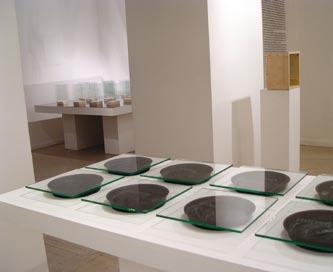

rezultat daje stvaranje novog, nečijeg
Chronicle and More Concepts show precisely two (possible) situations of that magic of creating, and at the same time two (possible) logical lines of research of subjectile. Taking into consideration Derrida’s interpretation of the term as a space where “totality of objects, configurations and participations” can be found, which is interpreted by many as the site, as well as Pierre Bourdieu’s opinion on the relationship between an artist’s habitus and her/his working space, Slobodanka puts an accent via these two works of hers on that intuitive, non-rational moment, as a kind of creative play which has that primordial magic of creating in its background. In the first work mentioned, Slobodanka focuses on the process of creating, when a by-product can reach the level of an independent work as well; in the second work, it is an infinite number of possible endings at issue. The starting point is the same – a personal imaginary vocabulary which comprises words and terms from three languages as marked points of the space – subjectile – of the artist’s own personal life. Coincidence, both as contrast and correspondence of the planned construction of previously mentioned works, is only one more possibilities of the act of creating. In the first work, a random order of graphemes created as a part of the process of creating is immortalised by an artificial eye (camera lens); in the second work, in the recognisable representation (engraving with diamond on glass), they are left to the mercy of waves and winds
Misterija Pisma, Kaos galerija Keln 1997. Mystery of Letters, Kaos Gallery Cologne 1997.Nivo Pojmova, 2004. Level of Concepts, 2004.
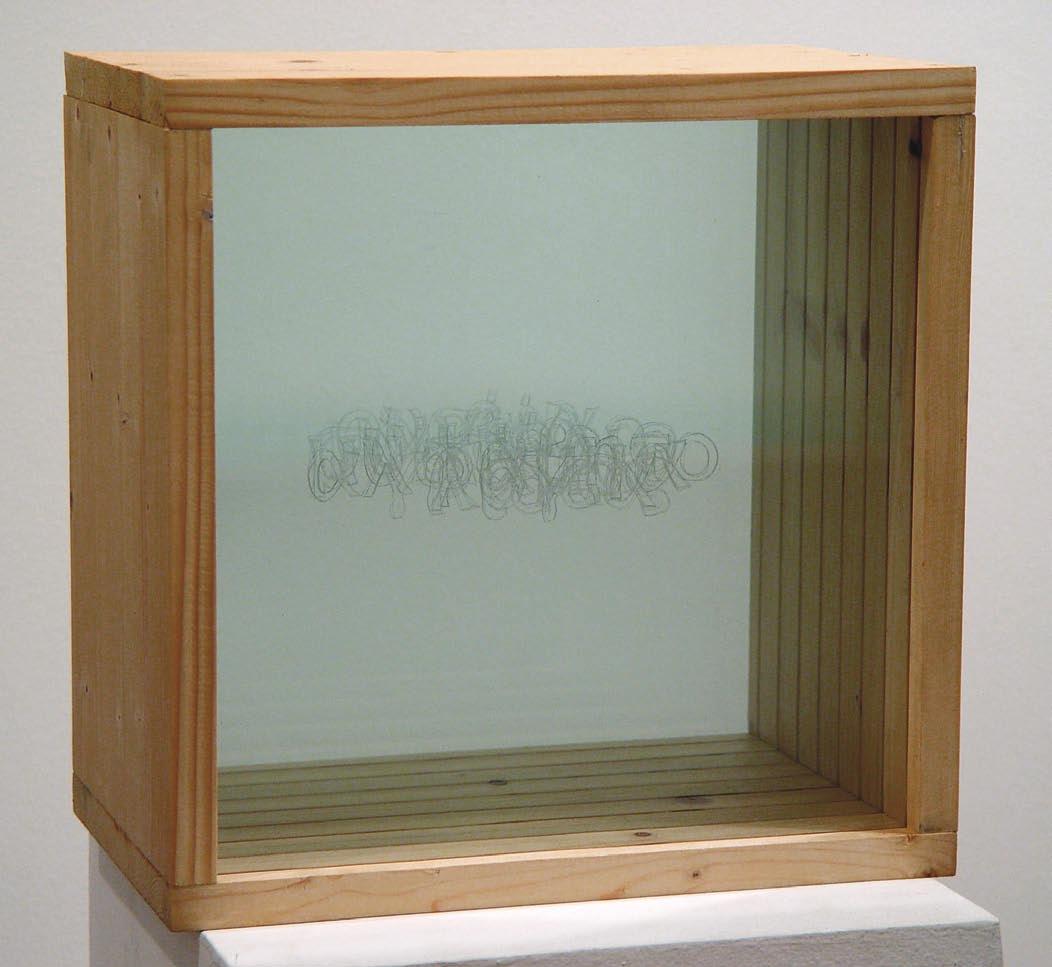
ličnog jezika, čime je ostvaren i ontološki preduslov istraživanja Deridinog subjectil-a.
Baš kao što se junak filma “Izgubljen u prevodu”
(Lost in traslation) u početku, kada se nadje u sasvim drugačijem lingvističkom okruženju od njegovog, nalazi u autističnoj situaciji, i tokom trajanja filma otkriva upravo lepotu u toj nemogućnosti uobičajene komunikacije, tj. u komunikaciji pomoću drugih vizuelnih i verbalnih reprezenata, tako i Slobodanka Stupar magiju stvaranja vidi u procesu “prevodjenja”
koji se zasniva na dekonstrukciji
postojećeg da bi se stvorilo novo. Jer se subjectil ispostavlja “...kao neprevodiv, to je aksiom...”
i on ne može “...
nikad da bude prenesen/transportovan u drugi jezik. Osim ukoliko se ne prenese netaknut, kao strano telo.
Sve u svemu čovek bi mogao da uzme slobodu da zaključi: 1. Ono što tako radikalno prevazilazi prevodjenje pripada suštinski/originalno jeziku; 2. Ono što tako radikalno prevazilazi lingvisticki transfer ostaje, suprotno tome, strano jeziku kao elementu diskursa; 3. Reč “subjectil” jeste sama subjectil” (Derrida, Forcener le subjectile, Pariz, 1986).
of semantic combinations. Choosing number 3 as a common formal framework of the statement, the same goal is emphasized – creating one’s own language whose translation results in creating a new, someone’s personal language, which offers an ontological prerequisite for exploring Derrida’s subjectile. Just like the main protagnonist at the beginning of the film Lost in Translation, who is in an autistic-like situation when he finds himself in a totally different linguistic environment from his own, and who is discovering, along the way, the very beauty in that impossibility of normal communication, i.e. in the communication by means of other visual and verbal representative forms, Slobodanka Stupar sees the magic of creating in the process of “translating” which is based on deconstruction of the existing in order to create something new. Because “a subjectile appears to be untranslatable, this is the axiom, […]” and “one will never transport it into another language. Unless one imports it intact, like an alien body. One will be altogether at liberty to conclude1. That which thus exceeds translation belongs genuinely to language. 2. That which so radically exceeds linguistic transfer remains, in contrast, alien to language as an element of discourse. 2. The word “subjectile” is itself a subjectile […]” (Derrida, Forcener le subjectile, Paris 1986.)
Sava Ristović, april 2008.
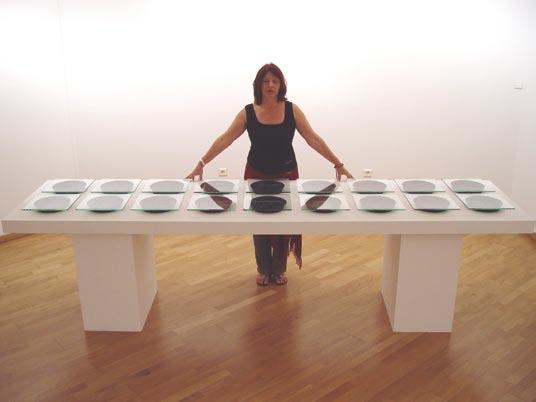 Sava Ristovic, April 2008.
9x2 je više od 18 Titanium galerija Atina 2004. 9x2 is more than 18 Titanium Gallery, Atihens 2004.
Sava Ristovic, April 2008.
9x2 je više od 18 Titanium galerija Atina 2004. 9x2 is more than 18 Titanium Gallery, Atihens 2004.

/ More Concepts / More Pojmova 2006.
staklo gravirano dijamantom, drvo diamond engraved glass




 Επιπλέον έννοιες / More Concepts / More Pojmova 2006.
Επιπλέον έννοιες / More Concepts / More Pojmova 2006.
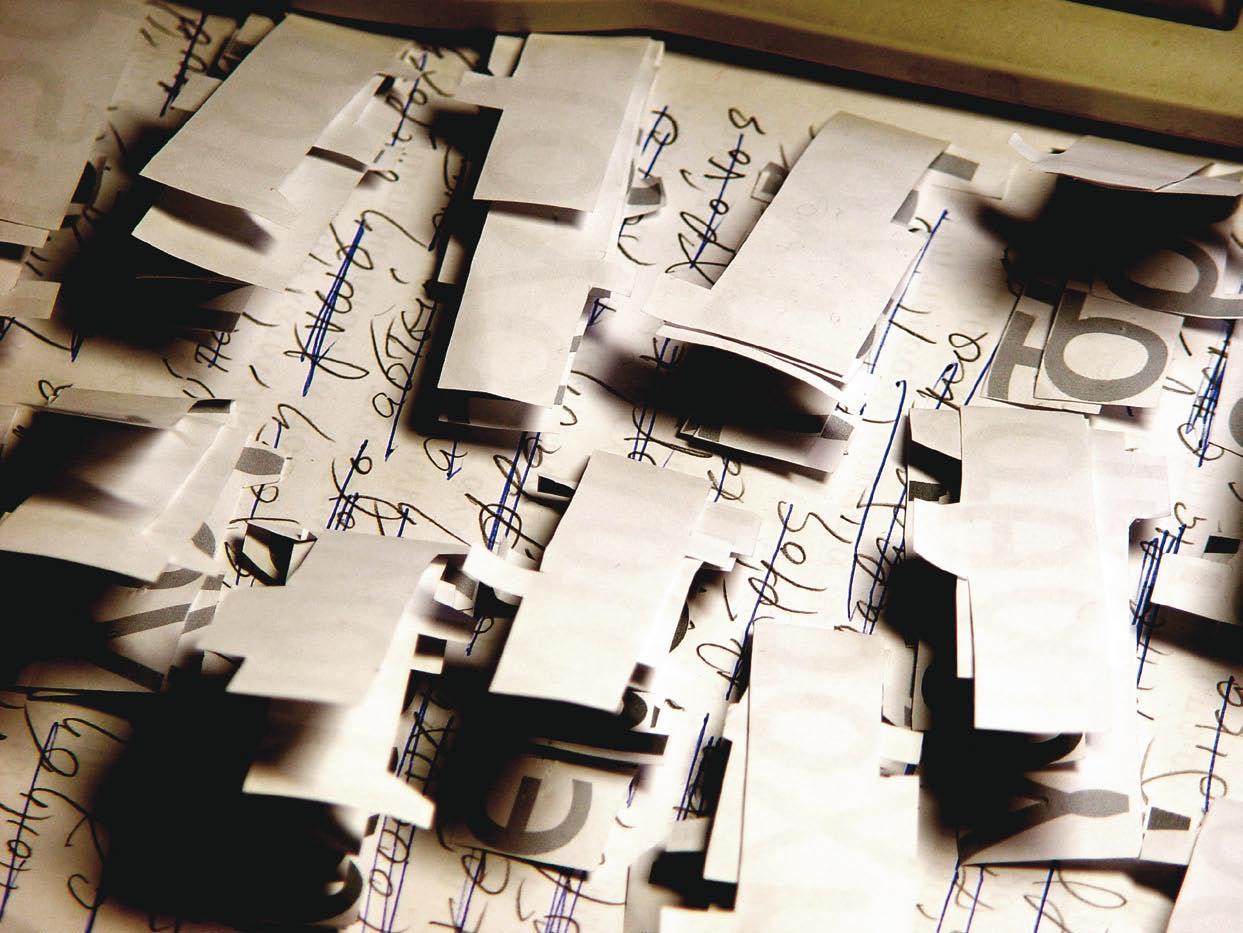


Chronicle, 2006. print, metal, zvučna instalacija, Internacionalni foto susreti Muzej fotografije Solun 2007.
Chronicle, 2006 print, metal, sound installation, International Photo Meeting Museum of Photography, Thessaloniki 2007.
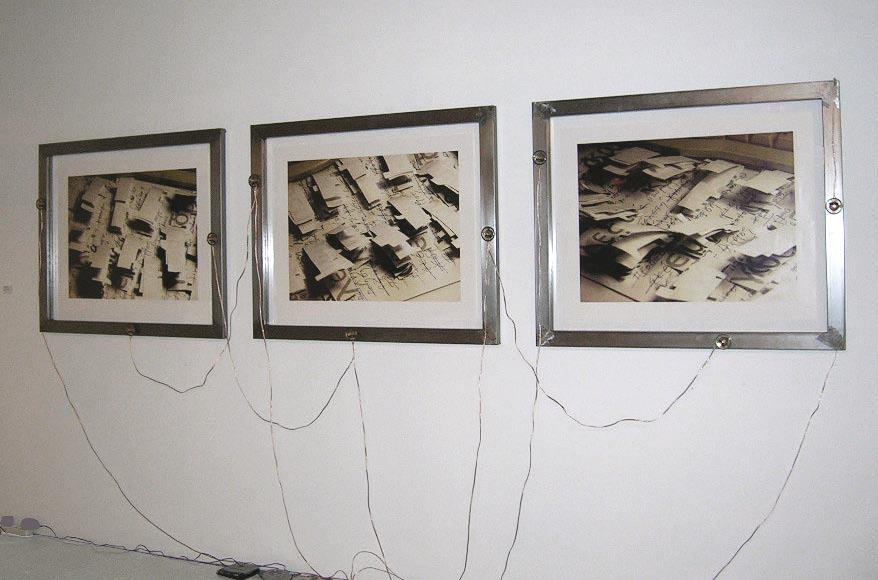

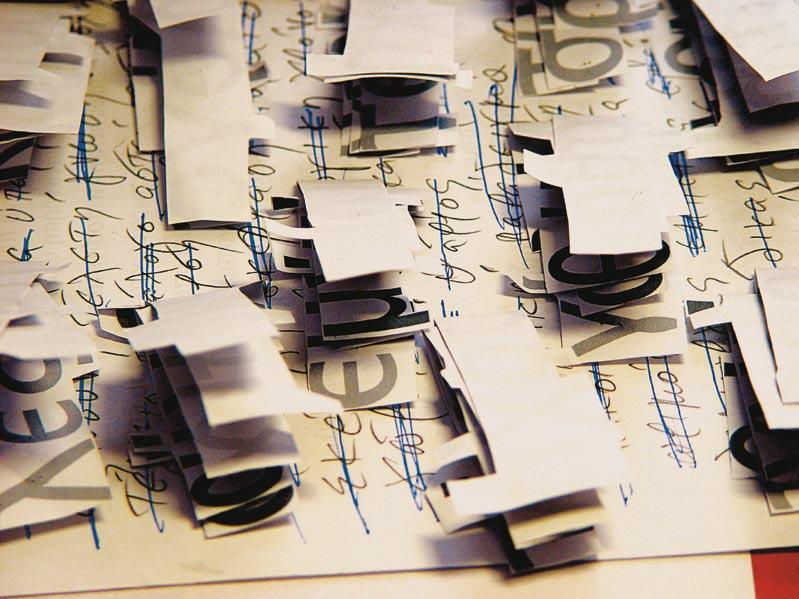
Chronicle, 2006. print na papiru, dimenzije promenljive
Chronicle, 2006. print on paper, dimensions variable

Slobodanka Stupar, rođena 1947. u Sarajevu. Diplomirala unutrašnju arhitekturu i grafiku na FPU u Beogradu. Magistrirala grafiku na FLU u Beogradu. Specijalizirala grafiku na Školi Lepih Umetnosti u Atini.
Stipendije i boravci: Stipendija “Mladi umetnici”, Beograd
Stipendija „Moša Pijade“ za studijski boravak u Londonu Stipendija Ministarstva Prosvete Grčke
Stipendija „Fondation pour une Entraide Intellectuelle Europeene“, Pariz
Stiftung Kulturfonds Haus Lukas Aahrenshop, Nemačka
Nagrade i priznanja: Nagrada za grafiku Oktobarskog Salona Beograda Nagrada za skulpturu Likovne kolonije Željezara Sisak
Otkup Nacionalne Sveučilišne Biblioteke na XII Zagrebačkoj izložbi jugoslovenskog crteža
Grand Prix IX Internacionalnog grafičkog trijenala Frechen, Nemačka
2. Nagrada na Bijenalu Suva igla, Užice Otkupna nagrada Narodnog muzeja na Beogradskom Međunarodnom grafičkom bijenalu Nagrada na Fotowettbewerb Award 1999. Stuttgart
Dela u muzejima i javnim kolekcijama: Muzej savremene Umetnosti Beograd; Ludwig Muzej Keln; Narodni Muzej Begrad; Muzej grada Beograda; Narodni Muzej Kraljevo; Nacionalna Pinakoteka Pirej, Grčka; American College of Greece, Atina; Savremena Galerija Zrenjanin; Zbirka Nacionalne Sveučilišne Biblioteka Zagreb; Zbirka „Lazar Vozarević“, Sremska Mitrovica; Fondacija „Zepter“ Beograd; Grafička zbirka Frechen, Nemačka; Muzej međunarodne savremene grafike Fredrikstad, Norveška; Zbirka „Grafički Kolektiv“ Beograda; Zbirke kolonija Sisak, Poreč, Tuzla, Sopoćani dr.
Samostalne izlozbe / izbor
Artforum galerija, Solun
Diana galerija, Atina
Galerija Kulturnog centra Beograda
Artforum Galerija, Solun
Christuskirche, Keln
Galerija Zepter, Beograd
Galerija Kaos, Keln
Galerija Zlatno Oko, Novi Sad
BAP Witten, Nemačka
Galerija BBK, Keln
Rathaus Keln
Simultanhalle galerija, Keln
Galerija Ligue Franco-Hellenique, Atina
Galerija Rozmarin, Minhen/Olching
Galerija Kulturnog Centra Beograd
Art Gallery Hristos Kyriazis, P. Faliro/Atina
Galerija Kreonidis, Atina
Jugoslovenski Kulturni centar Beč
Slobodanka Stupar was born 1947. in Sarajevo. She graduated from Academy of Applied Arts in Belgrade (B.F.A.) and from Belgrade University School of Fine Arts (M.F.A.). She specialized in graphic arts at the School of Fine Arts in Athens.
Grants and residencies:
“Young Artists” grant, Belgrade
“Mosa Pijade” grant for residence in London
Scholarship from Greek Ministry of Education
The Grant of “Fondation pour une Entraide Intellectuelle Europeene”, Paris
Stiftung Kulturfonds, Haus Lukas, Ahrenshoop (Germ.)
Awards and recognitions:
October Salon Price for Graphic Art, Belgrade
Art Colony Sisak Price for Sculpture (Yu/Croatia)
Purchase Price from the National University Library at XII
Exhibition of Contemporary Yugoslav Drawing, Zagreb

Grand Prix at the IX International Graphic Triennial Frechen, Germany.
2. Price at Biennial of Dry Point, Uzice (Yu)
Purchase Price from National Museum at Belgrade International Biennial of Graphic Art
Price at Fotowettbewerb Award 1999. Stuttgart
Works in museums and public collections:
Museum of Contemporary Art Belgrade; Ludwig Museum Cologne; National Museum Belgrade; Museum of city of Belgrade; National Museum Kraljevo; National Gallery of Piraeus, Greece; American College of Greece, Athens; Gallery of Contemporary Art
Zrenjanin; Art Collection of the National University Library Zagreb; Art Collection “Lazar Vozarevis”, S. Mitrovica (Yu); Art Collection ”Zepter” Belgrade; Collection of Graphic Art Frechen, Germany; Museum of International Contemporary Graphic Art Fredrikstad, Norway; Collection “Graficki Kolektiv of Belgrade”; Collections of Art Colony Sisak and Porec, Art Colony Tuzla, Sopocani
Selected solo exhibitions:
Gallery Artforum, Thessaloniki
Diana Gallery, Athens
Gallery Cultural Centre, Belgrade
Gallery Artforum, Thessaloniki
Christuskirche Cologne
Gallery Zepter, Belgrade
Gallery Kaos, Cologne
Gallery Zlatno Oko, Novi Sad (Yu)
BAP, Witten, Germany
Gallery BBK, Cologne
Rathaus Koeln, Cologne
Simultanhalle, Cologne
Gallery Ligue Franco-Hellenique, Athens
Gallery Rozmarin, Munich / Olching
Gallery Cultural Centre, Belgrade
Art Gallery Christos Kyriazis, P. Faliro/Athens
Gallery Kreonidis, Athens
Yugoslav Cultural Centre Vienna
Galerija KNU, Beograd
Galerija Richard Demarco, Edinburg
Galerija Sebastian, Varaždin
Narodni Muzej Kraljevo – Gospodar Vasin Konak
Narodni Muzej Novi Pazar
Studio galerije Forum, Zagreb
Narodni Muzej Kragujevac – Mali likovni salon
Galerija Sebastian, Dubrovnik
Galerija Grafički Kolektiv
Grupne izložbe i festivali / izbor
Chronicle of the Absurd, Muzej fotografije, Solun New Forms Festival, Vancouver, Canada
Intro/Out Video festival, Solun
Internacionalni festival umetničkih zastava, Zlatno Oko Novi Sad
“Erasing”, internacionalni projekat, Muzej 25 Maj Beograd
In The Biginning Was Fire, Titanium galerija, Atina
Jedan vek grafike, iz zbirke Muzeja Savremene Umetnosti, Srpska Akademija Nauke i Umetnosti, Beograd
44 th Octobarski Salon - Pozitiv/Negativ, Beograd
43rd Octobarski Salon - Zoom in zoom out, Beograd
2002. Paths of History, Zakynthos , Gr
2002. Terra Incognita, Diana galerija, Atina Kolekcija Fonda Zepter
Commentary on the Twentieth Century, Artforum galerija, Solun The Must Recommendation, Artforum Gallery, Solun
10 godina Kolonije Galicnik, Muzej savremene umetnosti, Skopje Slikari Novog Beograda, Muzej Savremene umetnosti Beograd
Köln Kunst 5, Keln Eshylaeia 97. Eleusina Visible / Invisible, Solun Kulturna prestonica Evrope1997. Coincidence, Keln Tragovi/Zapisi, Galerija Paratiritis, Solun
4. Internacionalni grafički Bienale, Beograd
Ars Futura, Keln Oktobarski Salon Beogard Tangenten Festival, Köln/Mülheim, Nemačka
Köln Kunst 4, Keln Sickingen Kunstpreis, Kaiserslautern
3. Internationalni Grafički Bienale, Beograd
Seven Artists from Belgrade, Atina
2. Internacionalni Bienale grafike, Beograd
13. Zagrebačka izložba jugoslovenskog crteža, Zagreb
19. Internacionalni Grafički Bienale, Ljubljana
7. Trijenale savremene jugoslovenske grafike, Bitola
9. Internacionalni Grafički Trienale, Frechen, Nemačka
2. Mediteranski Grafički Bienale, Atina
Savremeni Jugoslovenski
Internacionalna izložba grafike, Fredrikstad
Six Yugoslav Artists at Cultural Centre of Athens
Tajni Život Grada, Beograd
Druga Nova Muzika, Beograd
Savremeni Jugoslovenski crtež i grafika, Lisabon i Nikozija
1985.
Gallery KNU, Belgrade
Gallery Richard Demarco, Edinburgh
Galerija Sebastian, Varazdin
National Museum Kraljevo – Gospodar Vasin Konak
National Museum Novi Pazar
Studio of Gallery Forum, Zagreb
National Museum Kragujevac – Mali likovni salon
Gallery Sebastian, Dubrovnik
Gallery Graficki Kolektiv, Belgrade
Selected group exhibitions and festivals:
Chronicle of the Absurd, Photo Museum, Thessaloniki
New Forms Festival, Vancouver Canada
Intro/Out Video Festival, Thessaloniki
International Artistic Flag Festival, Gall. Zlatno Oko, Novi Sad
„Erasing“, International Art Project, Museum 25. May, Belgrade

In the Beginning was the Fire, Titanium Gallery, Athens
One Century of Graphic Art, Museum of Contemporary Art, and Serbian Academy of Arts and Sciences, Belgrade
44. October Salon - Positive/Negative, Belgrade
43rd October Salon - Zoom in zoom out, Belgrade
Paths of History, Zakynthos, Greece
Terra Incognita, Diana gallery, Athens
Collection of the Foundation Zepter
Commentary on the Twentieth Century, Artforum Gall.Thessaloniki
The Must Recommendation, Artforum Gallery, Thessaloniki
10 Years of Art Colony Galicnik, Museum of Contemp. Art Skopje
Artists of Novi Beograd, Museum of Contemporary Art Belgrade
Köln Kunst 5, Cologne
Eshylaeia 97. Eleusis
Visible / Invisible, Thessaloniki, Cultural Capital of Europe 1997. Coincidence Cologne
Traces/Notes, Gallery Paratiritis, Thessaloniki
4. International Graphic Biennial, Belgrade
Ars Futura, Cologne
October Salon, Belgrade
Tangenten Festival, Köln/Mülheim
Köln Kunst 4, Cologne
Sickingen Kunstpreis, Kaiserslautern
3. International Graphic Biennial, Belgrade
Seven Artists from Belgrade, Athens
2. International Graphic Biennial, Belgrade
13. Exhibition of Yugoslavian Drawing, Zagreb
19. International Graphic Biennial, Ljubljana
7. Triennial of Graphic Art, Bitola
9. International Graphic Triennial, Frechen
2. Mediterranean Graphic Biennial, Athens
Contemporary Yugoslav Drawing, Tempere and Rijeka
International Exhibition of Graphic Art, Fredrikstad
Six Yugoslav Artists at Cultural Center of Athens
Secret Life of Town, Belgrade
Second New Music Festival, Belgrade
Contemporary Yugoslav Drawing and Graphic, Lisboan and Nicosia
crtež, Tempere, Finska i RijekaOstali radovi:
„Simfonija“,teksualno/zvučna struktura u devet stavova, javno izvodenje na festivalu „Druga Nova muzika“, SKC Beograd i na festivalu “Tajni život grada” u Beogradu
“Prostor Dodira“ predavanje„Otvorena Djurdjevačka Škola“, Djurdjevo
“C’est ci ne pas une pipe”, live-video u galeriji Moltkerei Werkstadt
Keln, u okviru “Piazza Virtuale” projekta za Kassel Dokumenta 9.
“Ogledalo”, performans sa Lj. Jovanović, Simultanhalle Keln
„Ueber den Teillerrand hinaus“ performans sa Inge Broska i HansJoerg Tauchert, Festival Tangenten, Muelheim-Koeln
„Odgovori na moje pismo“, otvoreni komunikacijski umetnički projekt
« IF… ? », grupni performans, kolonija Galičnik, Makedonija
Izbor iz bibliografije / Selected bibliography
- Petar Gudelj, “Ako mi je malo svjetlosti (Napisano pred grafikama Slobodanke Marinović Stupar)”, pref. cat. solo exhib. Grafički olektiv, Belgrade 1979.
- Dušan Djokić, Umetnost 65, 1979
- Sonja Seferović, “Emotivne akvatinte Slobodanke Stupar”, Dubrovački vjesnik br. 1547, 6.6.1980
- Dušan Djokić, pref.cat. solo exhib, Studio Gallery Forum, Zagreb, 1982.
- Josip Depolo, “Slobodanka Stupar (Studio Gallery Forum”), “Oko” No. 22, 1982.
- Dušan Djokić, “Slobodanka Stupar i Vesna Zlamalik: Grafički izraz i osećanje prirode”, pref. cat. National Museum Novi Pazar, 1982
- “11 grafičkih listova”, pref. cat. Gallery Sebastian Varaždin, 1984
- Kosta Bogdanović, pref. cat. solo exhib. Gallery KNU Belgrade, 1985.
- Dušan Djokić, “Telo kao motiv, grafike i skulpture Slobodanke Stupar u galeriji KNU u Beogradu”, Borba 10.10.1985.
- Dušan Djokić, pref.cat. solo exhib, Gallery Dom kulture Smederevo, 1986.
- Zana Gvozdenović, “Grafike Slobodanke Stupar, pref. cat. solo exhib., Gallery of the Yugoslav Ciltural Centre, Vienna 1986. & Gallery “Kreonidis” Athens, 1987.
- “Stupar im Jugoslawischen Kulturzentrum”, Diplomatic Correspondence 1/87
- Nikos Aleksiou, “Slobodanka Stupar”, Rizospastis, 11.4.1987.
- “Najbolja djela – Salamun, Stupar”, Vjesnik Željezare Sisak, 12.6.1987.
- Aleksandar Djurić, “Budjenje Antropometrije iz nesvesti” pref. cat. solo exhib., Gallery of Cultural Centre Vranje, 1988. - Zana Gvozdenović, “Prevlast pokreta”, solo exhib. Gallery Cristos Kiriazis, Faliro/Athens 1988.
- Irina Subotić, “Ruke i krstovi”, pref. cat. solo exhib., Gallery KC Belgrade,1990.
-
Ljiljana Cinkul, “U galeriji KCB otvorena je izložba slika i crteža Slobodanke Stupar”, 3. program Radio Belgrade, 5.2.1990.
- D. Dević, “Beleenje dodira”, Narodne novine, 14.3.1990.
- Jasmina Tuturov, “Unutrasnji kosmos, uz izlozbu Slobodanke Stupar u savremenoj Galeriji u Zrenjaninu”
- “Oelgemaelde von Stupar”, Fuerstenfeldbrucker Tagblatt, 12. mart 1992 - “Spurensuche in der Natur, Die Galerie Rozmarin zeigt Werke der Kuenstlerin Slobodanka Stupar”, Muenchener Merkur, april 1992;
- “Der Reiz liegt im unmittelbaren Ausdruck Kuenstlerischen Wollens”, Fuerstenfeldbrucker Tagblatt, novembar 1992.
- Juergen Raap, “Quantenpool in der Moltkerei-Werkstatt” Koelner Ilus-
Kadrovi iz videa What is a Subjecdtile, 2007.
Other works:
“Symphony”, textual/sound structure in nine acts, live performances at the Festival “Second New Music”, Belgrade and at the Festival “Secret life of Town”, Belgrade
“Area of Touch / Space of Contact”, lecturing at “Djurdjevo Open School”
“C’est ci n’est pas une pipe”, live-video at Moltkerei Werkstat Gallery Cologne, for “Piazza Virtuale” project of Kassel Dokumenta 9.
“Mirror”, performance with LJ. Jovanovic, Simultanhalle Cologne
“Ueber den Tiellerrand hinaus“, performance with Inge Broska and Hans-Joerg Tauschert at “Tangenten” Festival, Koeln-Muelheim
„Answer to my Letter“, open art project upon art communication
“IF…?”, group performance at Galicnik Art Colony, FYROM
trierte, September 1992.
- Bernd v. den Brinken, Nachtsendung(3.15-3.45)”C’est ci n’est pas une pipe” – Slobodanka Stupar, Ljiljana Jovanovic”, Quantenpool Koeln, Vilter Verlag 1993.
- Dr. Bettina Mette, “Nine Doors to Nowhere” und “Vertical/The Passage”, pref. cat. solo exhib. Simultanhalle, Keln1995.
- Bruno Schneider, “Tueren, die ins Nichts fuehren, Slobodanka Stupar zeigt in der Simultanhalle eine Installation aus Reispapier, Spiegelstreifen und Stahlwolle”, Koelnische Rundschau/Koelner Kultur, 9.6.1995.
- Juergen Schoen, “Lichtspiele”, Koelner Stadt-Ainzeiger Nr.140, 20.6.1995.
- “Werke auslaendischer Kuenstler im Foyer des historischen Rathauses”, Koelnische Rundschau, 14.9.1995.
- M. Zivojinov, “Ogledalo slike i muzike”, Evropske Novosti 21.9.1995.
- Ursula Franck, “Slobodanka Stupar (Simultanhalle Cologne) Arti October 1995.
- Juenger Kuesters “Von Kunst und Alltag”, Koelner Stadt-ainzeiger 16/17.3.1996
- “Bilder voller Energie”, Ruhr Nachtrichten, 17.10.1996.
- Juergen Schoen “Geheimnis der Schrift” Ausstellung Stupar, Koelner Stadt-Ainzeiger Nr. 13, 16.1.1998.
- Gordana Stanisic, pref. cat. solo exhib., Gallery Zepter, Belgrade 1998.
- “Stepenice do neba”, Novosti, 24.1.1998.
- Mirjana Radojcic “Nedodirljivi prostori”, izlozba Slobodanke Stupar u galeriji Zepter, 1998. Politika 6.2.1998.
- Jovan Despotovic, “Vrata i drugi zapisi Slobodanke Stupar” 3. Program Radio Belgrade, Februay 1998.
- Jovan Despotovic, “Doors and other Notes of Slobodanka Stupar”, Arti, October 1998
- Bia Papadopoulos, Slobodanka Stupar, “Mistirio ton Grammaton”, pref. cat. Samostalne izlozbe, Artforum Gallery, Thessaloniki, 2002.
- Sava Ristovic, pref.cat. solo exhib., Gallery KC Belgrade, 2002.
- Lena Kokkini, pref. cat. solo exhib. Diana Gallery, Athens 2003.
- Bia Papadopoulos, “Witness” pref. cat. solo exhib., Diana Gallery Athens, 2003.
- Bia Papadopoulos, “Commentary on the Twentieth Century” pref. cat. group exhib., Artforum Gallery, Thessaloniki 2000.
- Lena Kokkini, pref. cat. group exhib. “Terra Incognita” Diana Gallery, Athens 2002.
- Milena Marjanovic, “Saputanja iz jastuka”, Blic, 8.10.2003.
- Bia Papadopoulos “In The Beginning Was Fire”, pref. cat. group exhib., Titanium Gallery, Athens 2004.
- Bia Papadopoulos, “Chronicle of the Absurd”, pref. cat. group exhib., Museum of Photography, Thessaloniki 2007.
What is a Subjectile, 2007. videosnapshots



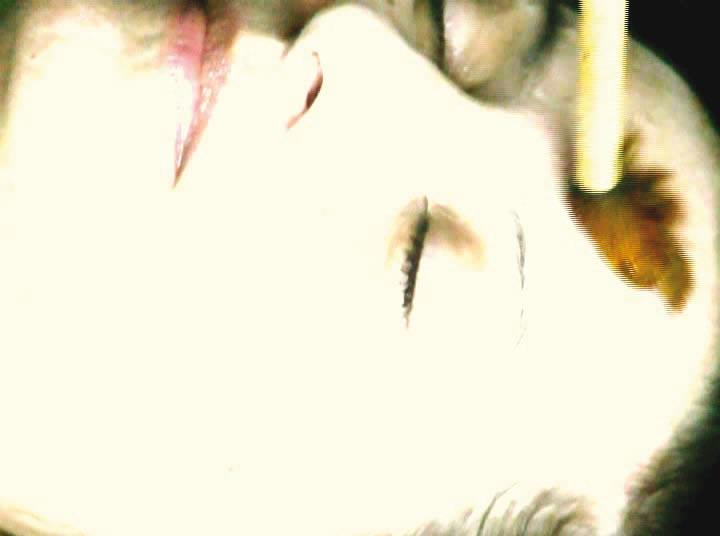
Izdavač / Publisher
Centar za kulturu Lazarevac
Centar za vizuelnu kulturu Zlatno Oko Novi Sad
Tekst / Text
Sava Ristović
Prevod / Translation
Irena Brkić
Foto / Photo
Vlada Popović
Slobodanka Stupar
Realizaciju izložbe pomogli / Supported by Ministarstvo za kulturu Republike Srbije
Sekretarijat za kulturu Beograda
Tiraž / Print-run 800
Štampa / Printed by Štamparija Akademije
CIP – Katalogizacija u publikaciji Narodna Biblioteka Srbije, Beograd (samo brojevi)